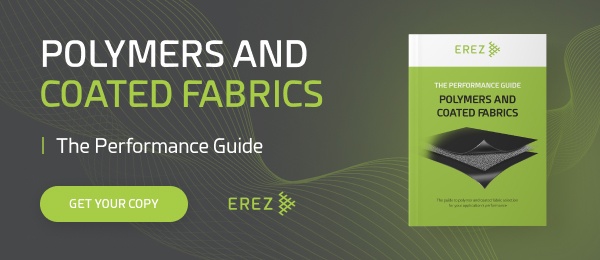What is aramid fabric and is it the right material for your product?
Flexible Storage Tanks, International StandardsFeb 8, 2023
Aramid, short for “Aromatic Polyamide”, is probably your next material to use on products. Material manufacturers are always looking for ways to optimize their products’ performance, durability, weight reduction – all while keeping costs low.
When researching materials with strong mechanical properties, aramid fabric is likely to come up. Aramid fabric is a synthetic fiber known for its exceptional strength, durability, and thermal insulation properties, and used regularly for applications that need to withstand tough conditions.
Here, we’ll delve into the physical structure of aramid fabric and explore how it can benefit manufacturers who are looking for a highly durable material.
TALK TO A TECHNICAL TEXTILE EXPERT TODAY→
What is Aramid fabric?
Aramid is a family of strong synthetic materials, with Kevlar being the most well-known. It was invented in the 1960s by Stephanie Kwolek, a Polish-American chemist working at DuPont. Her research aimed to create a lightweight, durable material to replace nylon in tires, leading to the development of Kevlar, which was introduced to the market in 1973. Over time, other companies began producing similar aramid fibers under different names.
Aramid fibers are known for their exceptional properties, including high cut resistance, impact and abrasion resistance, heat resistance, and low weight. These qualities make them ideal for use in protective clothing, military and aerospace applications, tires, gloves, and various sports equipment. The range of applications for aramid continues to expand annually.
Factors that determine coated fabric durability on Aramid
The Base Fabric
The durability of any fabric depends on a variety of factors. One key factor is the weave density, which refers to the number of threads per square inch in a woven fabric. A fabric with a higher weave density will typically be more durable and long-lasting, as there are more threads to support the weight and stress placed on the material. Other factors that can impact the durability of a fabric include the quality of the yarn or fiber used, the finishing process used to treat the material, and the overall design and construction of the fabric.
Get the guide on base fabrics here.
The Coating
The purpose of textile coating is to enhance the properties of the base fabric, such as its strength, durability, and resistance to water, fire, chemicals, and other environmental factors.
Textile coating is a process of applying a layer of polymer or other materials onto the surface of the fabric, which can alter its physical and chemical properties. Coating can be done on a wide range of fabrics, including natural fibers like cotton and wool, as well as synthetic fibers like polyester and nylon. Some of the benefits of textile coating include improved durability, water resistance, UV resistance, and flame retardancy. Coating can also add decorative elements to the fabric, such as patterns and colors. Overall, textile coating is an essential process in the textile industry that can help to improve the performance and functionality of fabrics for a variety of applications.
Is Kevlar® Made from Aramid Fabric?
Anytime aramid fabric comes up we must address Kevlar®. The reason being that Kevlar® is a brand name for a type of aramid fiber that was developed by DuPont in the 1960s. The brand has established itself to the point of being a proprietary eponym (When a brand becomes so strong that it eventually replaces the name of the object).
Kevlar® is a specific type of aramid fiber that is made from a polymer called poly-para-phenylene terephthalamide (PPTA).
This polymer is spun into fibers, which are then woven or knitted into fabrics, and these fabrics are used to make a wide range of products, including body armor, helmets, and reinforced tires. Kevlar® is known for its high tensile strength, excellent resistance to abrasion and impact, and its ability to withstand high temperatures.
Chemical Structure of Aramid Coated Fabric
Aramid coated fabric is made from a synthetic fiber called aramid, which has a unique chemical structure that contributes to its exceptional strength and durability. Aramid fibers are composed of long chains of molecules that are linked by strong hydrogen bonds. These bonds provide the fibers with excellent tensile strength, making them resistant to wear and tear. Additionally, the hydrogen bonds in aramid fibers make them highly resistant to thermal degradation, ensuring that they can withstand high temperatures.
When looking for an exceptionally durable material, it is important to first understand the specifications of the base fabric and coating. When these factors are produced as described above with the right weave density and coating, aramid coated fabric can offer exceptional mechanical performance, thermal insulation properties, abrasion resistance and can be crafted to be lightweight.
Ensure the Highest Performance Standard for Your Product
Aramid coated fabric is a versatile and durable material that offers exceptional mechanical performance, thermal insulation properties, abrasion resistance, and lightweight. The unique chemical structure of aramid fibers contributes to their exceptional strength and durability, making them ideal for oil booms, lifting bags, weight bags, hyperbaric chambers, inflatable boats and marine safety products. The material’s mechanical performance, thermal insulation properties, and abrasion resistance make it ideal for use in harsh marine environments. Additionally, its light weight ensures that it does not impact the performance of the product. By choosing aramid coated fabric, manufacturers can ensure that their products meet the highest standards of performance and durability.

Share this Post



